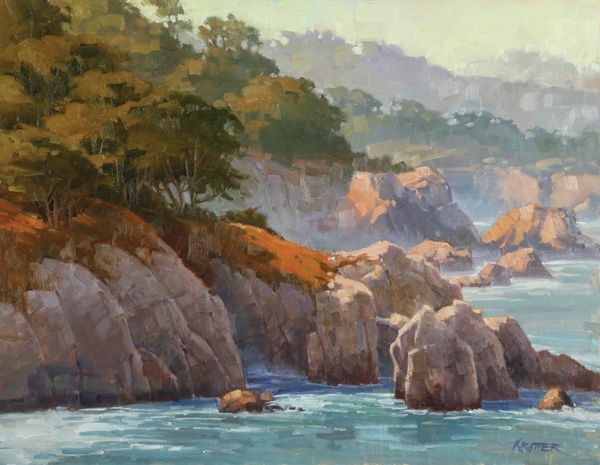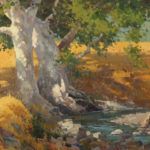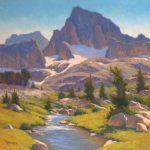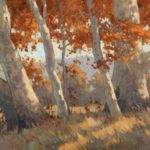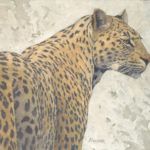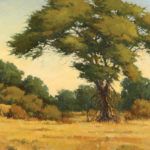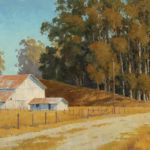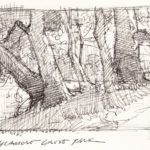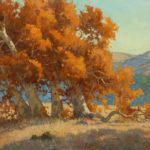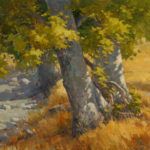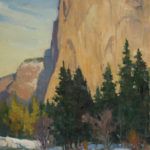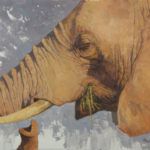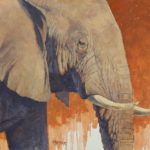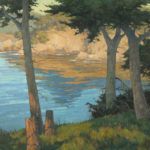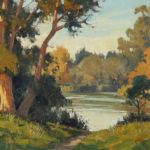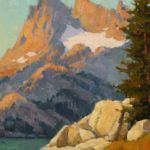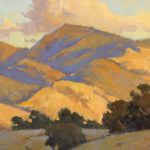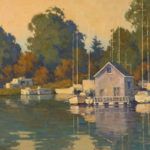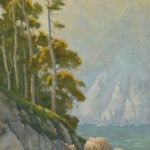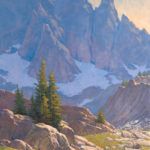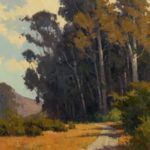Paul Kratter’s plein-air landscapes and animal portraits feature subjects dear to his heart
By Norman Kolpas
This story was featured in the June 2019 issue of Southwest Art magazine. Get the Southwest Art June 2019 print issue or digital download now–then subscribe to Southwest Art and never miss another story.
Tag along as Paul Kratter begins one of his plein-air paintings, and you won’t necessarily witness the approach you might expect. Of course, like other artists who pursue the challenges and pleasures of painting in the open air, he’ll first scout his location, seeking an aesthetically rewarding scene and the perfect vantage point. But if you think he’ll then set up his easel, pick up his brush, and immediately go to work, think again.
Instead, Kratter will likely begin a much more detailed investigation of the scene, as he did with FROM UNDER THE SYCAMORES, painted last December at Sycamore Grove Park in Livermore, CA, which is not far from his home in Moraga, just east of San Francisco Bay. Having spied a particularly attractive grove, Kratter didn’t simply succumb at first glance to that view. Instead, he recalls, “I walked underneath and behind that grove, and when I got way up close, it was beautiful just seeing the trunks and the shadows coming off of them, with full trees and gray hills in the distance. The pattern of those trunks was what I was after here. I really like organic shapes, and most people know me for the trees that I do.”
- Paul Kratter, Creekside Autumn – Curry Canyon, oil, 16 x 20.
- Paul Kratter, From the Source, Mt Banner, oil, 24 x 24.
- Paul Kratter, From Under the Sycamores, oil, 12 x 20.
Had the time at last arrived to turn to his easel, canvas, and paints? No. Kratter grabbed a 5-by-8-inch spiral-bound sketchbook and a cheap black ballpoint pen. Using a rapid, fluid crosshatching style he first began developing during childhood, he spent about 10 minutes making a 2-by-3-inch drawing, blocking out and simplifying the shapes before him, figuring out the composition and values. “I start with maybe five or six little lines where the major shapes are and then start building up the values, pushing down harder to make it darker or sketching lightly to get lighter values.”
Only then did he actually start applying paint to canvas, again blocking in the darker shapes first and gradually working his way to lighter hues, adding more and more detail until his painting was done about three hours later. “And if the shadows changed a little” while he was working, he says, “I had my sketch to refer to.”
Such a combination of spontaneity and deliberation, inspiration and mastery, have become hallmarks of Kratter’s work, winning the 62-year-old artist admiration and awards since he first dedicated himself to plein-air painting 15 years ago. Those same qualities also fueled the successful career that came before it.
- Paul Kratter, Leopard, oil, 16 x 18.
- Paul Kratter, On the Move, oil, 20 x 48.
- Paul Kratter, Summer Pallet, oil, 16 x 20.
Kratter’s first award for art came long ago—but, he says, “It was the most important award I ever won.” In kindergarten, his drawing of an animal was chosen to receive a special prize: a free key that activated the audio boxes explaining exhibits at the San Francisco Zoo. The award not only nurtured what has become a lifelong love of the world’s wildlife, but also confirmed in him a simple truth: “I always knew I was going to be an artist.”
Throughout grade school and beyond, he received strong encouragement from his parents, who also supported his love of sports, especially tennis and basketball. “If I wasn’t playing sports, I was drawing,” Kratter says simply. At Mills High School in Burlingame, art teacher Robert Smith’s classroom provided another environment to foster his talent. “I was in there all the time working on things,” he adds. In his senior year, he won the Bank of America Award for art.
After high school, while completing a two-year associate degree in graphic arts at the College of San Mateo, he heard about the widely respected Art Center College of Design in Pasadena. “I sent away for a catalog and was totally hooked. That was the only school I applied to. Fortunately, I got in,” he says. He entered the following year with the goal of becoming an illustrator. “It changed my life and my outlook,” he says. “The program was hard and rigorous, but I was well-prepared and ready for it. I worked my butt off there. But I also loved it.”
- Paul Kratter, Autumn’s Last Breath, oil, 16 x 20.
- Paul Kratter, Creekside, Curry Canyon, oil, 16 x 20.
Art Center fostered in him a dedication to one of his most treasured skills: sketching. “You could rarely do an assignment there without doing a sketch. Once you got up to about the third term, you usually had to bring in two or three or four sketches for an assignment, and the teacher would critique them before you did the finished illustration for the next week.” That process, he says, is why “I am now pretty well-known in the plein-air world for posting all of my sketches online along with my
finished paintings.”
Another significant event occurred at Art Center. In 1979, the year before graduation, he started dating another student, Tia. They married in 1981 and had two sons—Joel, now 35, and Marshall, 30. Tia has now worked for 26 years for Pixar Animation Studios after launching her career at Disney.
Paul, meanwhile, embarked on a highly successful illustration career, specializing in two subjects for which he felt true passions: sports and nature. “And I could turn almost any assignment into a sports or nature assignment, if there was any kind of leeway at all,” he laughs. Among his sporting triumphs were completing, in a five-year period, more than a hundred pieces of artwork for the National Football League, including a gatefold book illustration commemorating the victory of his beloved San Francisco 49ers over the Cincinnati Bengals in Super Bowl XVI in 1982. As a lifelong fan of the San Francisco Giants baseball team, he took a lot of ribbing from another regular client: the Los Angeles Dodgers, for whom he created posters, yearbook illustrations, and many other assignments.
- Paul Kratter, El Capitan in Light, oil, 12 x 9.
- Paul Kratter, Elephant Grazing, oil, 16 x 20.
- Paul Kratter, Elephant Portrait, oil, 16 x 20.
Opportunities to celebrate the world of animals, meanwhile, came from clients like The Nature Company; numerous zoos, museums, and aquariums; and a few advertisers. But his favorite project was a labor of love entirely of his own creation: a children’s book called The Living Rain Forest: An Animal Alphabet, which he researched, wrote, and illustrated over a seven-year span. Published in 2004, it sold very well and went on to win an award from Communication Arts magazine.
“And, just through happenstance, that’s the very last commercial job I ever did,” he adds. Not that Kratter was looking to end his illustration career. But by the early 2000s, computer technology was decreasing the demand for his kind of finely crafted artwork. Assignments were becoming scarcer. Fees were going down. “To put a sports metaphor to it, I hit a walk-off home run and then retired from baseball.”
Meanwhile, in the late summer of 2004, Kratter decided to attend the inaugural Sonoma Plein Air Festival. “I knew a few people in the event, former illustrators in the same spot I was, and I was looking for something new to do,” he remembers. “And I loved, loved, loved the work. The next day, I went to the art store, bought a set of oil paints, went out into my backyard, and started painting. I hadn’t used oils since college.”
- Paul Kratter, Golden Cliffs, oil, 20 x 24.
- Paul Kratter, Lakeside, Fall Colors, oil, 9 x 12.
- Paul Kratter, Minaret Morning Glow, oil, 8 x 10.
Within a few months, he’d completed several dozen paintings. That’s when Tia stopped him in his tracks with the words, “We need to talk. What are you going to do now? You need to think of the business side.” Soon, Kratter was sending slides of his works to galleries and group shows. Representation, sales, and awards began to follow.
He also delved deeper into the craft behind his art, taking workshops from established plein-air painters like Matt Smith and Ray Roberts, as well as studying the works of past greats like Edgar Payne, William Wendt, Sam Hyde Harris, and Percy Gray. Eventually, he began to teach workshops himself, became heavily involved in the California Art Club as co-chairman of its San Francisco chapter, and, until last year, taught illustration and landscape painting at the Academy of Art College in San Francisco.
Kratter even became involved in his own mini art movement, which has come to be called the Granite Group. Around the time he launched himself into plein-air painting, his friend Bill Cone, a pastelist who also works full-time at Pixar, suggested they recruit other like-minded artists for a weeklong painting pack trip high into the eastern Sierra Nevada, complete with a cook to take care of meals. “We’ll be able to paint from sunup to sundown,” said Cone. This August will mark the Granite Group’s 16th such trip. FROM THE SOURCE, MT. BANNER, a 24-by-24-inch piece Kratter painted in his studio based on plein-air studies from such a trip, speaks well to the soaring inspiration these journeys provide.
- Paul Kratter, Mount Diablo, Golden Hour, oil, 6 x 12.
- Paul Kratter, Owl Harbor Light, oil, 15 x 28.
- Paul Kratter, Rising Above, oil, 30 x 5.
In recent years, still more inspiration—and the opportunity to create paintings of the animals he has long loved—has come from safaris. On a 2015 trip with Tia to South Africa and Botswana, Kratter took some 3,000 reference photographs; for two weeks this month, the couple will return to visit private reserves near South Africa’s Kruger National Park. Originally, such adventures led him to paint scenes combining wildlife with landscapes, like ON THE MOVE, which appeared in last year’s California Art Club Gold Medal Exhibition. But lately, he’s been experimenting with portraits in which the animal is surrounded by a background of loose brush strokes that enhance a sense of drama and intimacy.
That’s not to suggest, however, that Kratter has any plans to forsake the open air for the studio. “There’s just nothing like painting live outdoors,” he says. “What I do, I take very, very seriously—but trying to capture a scene in only a few hours is just darn fun.”
representation
Nancy Dodds Gallery, Carmel, CA; Holton Studio Gallery, Berkeley, CA; Christopher Queen Galleries, Duncans Mills, CA; Sekula’s Fine Art Gallery, Sacramento, CA.
- Paul Kratter, Sky Bound, oil, 30 x 24.
- Paul Kratter, Standing Tall, oil, 16 x 20.
This story was featured in the June 2019 issue of Southwest Art magazine. Get the Southwest Art June 2019 print issue or digital download now–then subscribe to Southwest Art and never miss another story.
MORE RESOURCES FOR ART COLLECTORS & ENTHUSIASTS
• Subscribe to Southwest Art magazine
• Learn how to paint & how to draw with downloads, books, videos & more from North Light Shop
• Sign up for your Southwest Art email newsletter & download a FREE ebook






